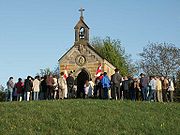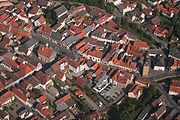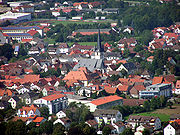
Bad Staffelstein
Encyclopedia

Bavaria
Bavaria, formally the Free State of Bavaria is a state of Germany, located in the southeast of Germany. With an area of , it is the largest state by area, forming almost 20% of the total land area of Germany...
n Administrative Region
Regierungsbezirk
In Germany, a Government District, in German: Regierungsbezirk – is a subdivision of certain federal states .They are above the Kreise, Landkreise, and kreisfreie Städte...
of Upper Franconia
Upper Franconia
Upper Franconia is a Regierungsbezirk of the state of Bavaria, southern Germany. It forms part of the historically significant region of Franconia , all now part of the German Federal State of Bayern .With more than 200 independent breweries which brew...
in Germany
Germany
Germany , officially the Federal Republic of Germany , is a federal parliamentary republic in Europe. The country consists of 16 states while the capital and largest city is Berlin. Germany covers an area of 357,021 km2 and has a largely temperate seasonal climate...
. It is known for the beautiful landscape that surrounds it, which has been given the name "Gottesgarten am Obermain" (Eden on the Upper Main). It contains many landmarks, such as the Basilica of the Vierzehnheiligen designed by Balthasar Neumann
Balthasar Neumann
Johann Balthasar Neumann , also known as Balthasar Neumann, was a [German] military artillery engineer and architect who developed a refined brand of Baroque architecture, fusing Austrian, Bohemian, Italian, and French elements to design some of the most impressive buildings of the period,...
, the former monastery of Banz Abbey
Banz Abbey
Banz Abbey , now known as Banz Castle , is a former Benedictine monastery, since 1978 a part of the town of Bad Staffelstein north of Bamberg, Bavaria, southern Germany.-History:...
, now Banz Castle, and the 540 meter high Staffelberg
Staffelberg
Staffelberg is a mountain of Bavaria, Germany. It is part of the Franconian Switzerland and one of the most important landmarks in Franconia. First settlements date from the neolithic Stone Age. Romans, Celts and Franconians followed. Nowadays, it is a famous tourists' attraction - not only because...
. Most recently, it has been the thermal salt water spa, for which the town received the title "Bad" in 2001, that has made Staffelstein a tourist attraction.
Bad Staffelstein Basilica:http://www.courses.psu.edu/nuc_e/nuc_e405_g9c/sonstiges/staffelstein/vierzehnheiligen2.jpg,http://www.courses.psu.edu/nuc_e/nuc_e405_g9c/sonstiges/staffelstein/vierzehnheiligen1.jpg,http://www.tourismusverein-badstaffelstein.de/images/basilika.jpg
Municipal Arrangement
Bad Staffelstein consists of the following boroughs:
|
Wiesen (Bad Staffelstein) Wiesen is a borough of Bad Staffelstein and lies away from town on the northern bank of the Main. The borough has 290 residents, 110 guest beds, and 2 Inn-Breweries... |
History
Staffelstein was first mentioned around 800800
Year 800 was a leap year starting on Wednesday of the Julian calendar. It was around this time that the Anno Domini calendar era became the prevalent method in Europe for naming years, so from this time on, the years began being known as 800 and onwards.- Europe :* December 25 - Pope Leo III...
and received its town status in 1130.
In 1846, with the construction of the Ludwig South-North Railway
Ludwig South-North Railway
The Ludwig South-North railway , built between 1843 and 1854, was the first railway line to be constructed by Royal Bavarian State Railways...
, the town was connected to the Bavarian rail network.
Kaider
Kaider is known for its stone industry, as well as for St. Mary's Chapel, which - prominently situated on a hill - can be easily seen from the state highway that runs from Bad Staffelstein to WattendorfWattendorf
Wattendorf is the smallest community in the Upper Franconian district of Bamberg and a member of the administrative community of Steinfeld.-Geography:...
and skirts the borough.
Kaider was earlier known as "Dabermannsdorf"; the change to the name "Kaider" has been proven to have taken place no later than 1542.
Kaider received its first mention on 12 December 1299. On that day, Albert von Giech, knight of Bamberg
Bamberg
Bamberg is a city in Bavaria, Germany. It is located in Upper Franconia on the river Regnitz, close to its confluence with the river Main. Bamberg is one of the few cities in Germany that was not destroyed by World War II bombings because of a nearby Artillery Factory that prevented planes from...
, sold with the agreement of his wife Elisabeth and his brother Kunimund, a canon
Canon (priest)
A canon is a priest or minister who is a member of certain bodies of the Christian clergy subject to an ecclesiastical rule ....
of Bamberg Cathedral
Bamberg Cathedral
The Bamberg Cathedral is a church in Bamberg, Germany, completed in the 13th century. The cathedral is under the administration of the Roman Catholic Church and is the seat of the Archbishop of Bamberg....
, all of his lands in "Nuweseze" (Neuses am Main), Obristfeld, and Dabermannsdorf (now Kaider) to Langheim Abbey
Langheim Abbey
Langheim Abbey was a well-known Cistercian monastery in Klosterlangheim, part of the town of Lichtenfels in Upper Franconia, Bavaria, Germany, in the Bishopric of Bamberg.thumb|250px|Ökonomiehof with decorated fountain at Eastern-History:...
. The selling price was 126 Pfund Bamberg Denars.

Schwabthal
Schwabthal lies 7 km east of Bad Staffelstein and has around 200 residents.Schwabthal is known for the Reha Hospital of the German Pension Fund Berlin and for its cuisine. The Reha Hospital, which is set back from traffic, can be reached in 10 minutes by foot from Schwabthal. It has over 180 beds and is well staffed. Not counting the Reha Hospital, Schwabthal has over 500 guest beds in vacation homes and guest rooms. Besides the Schwabthaler Sports Club (SSV), the town is also known for the Brick Oven Festival, with its Franconian specialities, that occurs there every August.
Incorporation
The District Reform of 1972 brought many changes to Staffelstein. Besides the District Office all other central administrations were dissolved. With the Municipal Territory Reform in 1978, the loss of administrative power and centrality became more balanced.Population Growth
- 1900: 1,724
- 1977: 4,985 (before the Municipal Territory Reform)
- 1978: 9,881 (after the Municipal Territory Reform)

Buildings
- On 5 July 1684, a fire destroyed almost the entire town center; therefore, most houses in Staffelstein today were first built after the fire.
- The Town Hall (built from 1684 to 1687), is a three-story Franconian half-timbered house and dominates the town's market squareMarket squareThe market square is a feature of many European and colonial towns. It is an open area where market stalls are traditionally set out for trading, commonly on one particular day of the week known as market day....
. - The Bamberg Tower (commonly referred to as the "Stadtturm") is the only remaining tower from the town fortifications. For some time, it has been used to exhibit art.
- Banz Abbey and castle
- Basilica of the Vierzehnheiligen


Regular Events
- Staffelsteiner Autofrühling (March)
- Songs an einem Sommerabend (July)
- Altstadtfest (End of July)
- Obermain-Marathon (April)
Clubs
- Colloquium Historicum Wirsbergense e.V., Bezirksgruppe Bad Staffelstein (history club)
- TSV 1860 Staffelstein (sports club)
- Musikverein Uetzing-Serkendorf (music club)
- Kultur-Initiative-Staffelstein e.V. (art and culture club)
People
- Adam Riese (1492–1559), mathematician
- His arithmetic books were used for instruction in schools well into the 18th century. Even today, one hears the German expression "Das macht nach Adam Ries(e)..." ("According to Adam Ries, that gives us...").
Modern
- Karl-Ludwig Ostertag-Henning, Der Apfelbaum im Gottesgarten. Staffelstein 1998, ISBN 3-9802943-6-6
- Bildende Kunst in Staffelstein. Hrsg. vom Arbeitskreis Kunst der Kultur-Initiative Staffelstein. Volume 1. Staffelstein 2000, ISBN 3-9802943-8-2
- Günter Dippold und Alfred Meixner (Hrsg.), Staffelsteiner Lebensbilder. Staffelstein 2000, ISBN 3-9802943-9-0
- Günter Dippold, Bad Staffelstein. Kleinod im Gottesgarten am Obermain. Stuttgart 2001, ISBN 3-09-303893-6
- Bildende Kunst in Staffelstein. Hrsg. vom Arbeitskreis Kunst der Kultur-Initiative Staffelstein. Volume 2. Bad Staffelstein 2002, ISBN 3-935302-01-0

